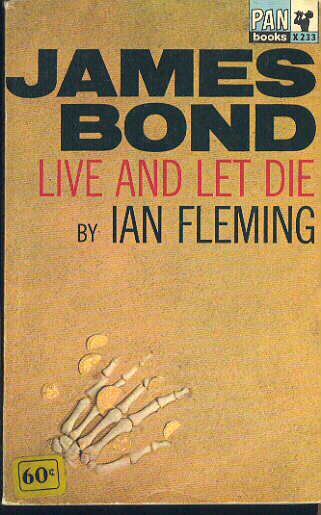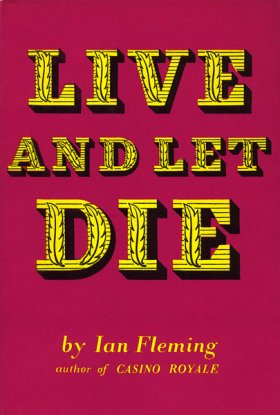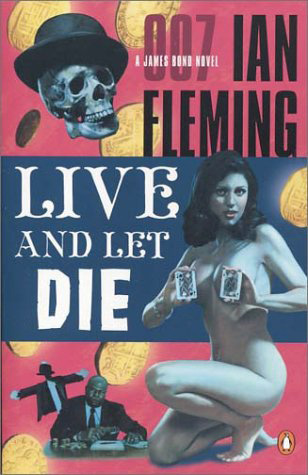Live and Let Die (1954, Ian Fleming)
Live and Let Die (1954, Ian Fleming)
B
A brief year following the publication of Casino Royale in 1953, Ian Fleming sees his second James Bond adventure released to readers. This is in fact a trend that would continue until the publication of the final 007 novel, as Fleming would take a few months ‘off’ every year and retreat to his private estate Goldeneye in Jamaica and concentrate on writing a new 280-330 page novel on each occasion. While the initial novel’s story transpired in a small fictional French town, Live and Let Die begins in a city that surely is a stranger to no one even if one has never been there, New York. It is a cold winter day as Bond leaves arrives in the Big Apple to begin a peculiar investigate into the world of…wait for it, the negro criminal underworld. Yes, a 1950s thriller written by a Caucasian Englishman in which the villains are all black. Better still, they are African American (Fleming loved the Americans overall but often inserted little snobbish complaints about their mannerisms and culture in the novels whenever 007’s adventures had American connections).That sounds like a book with a most promising level of potential.
Without delving too deeply into the details, of which there are plenty in the actual novel, Bond has received orders from M, head of MI6 back in London, to look into the sudden appearance of 17th century British gold coins within the African American community. A strange but unquestionably powerful man named Mr. Big is suspected of not only being the culprit of this scheme, but also of being SMERSH operative. Thus, the purpose of selling off of these valuable coins must certainly be to fund SMERSH operations within the United States. Mr. Big is considered to be a voodoo master, whose intimidation techniques and powers find their source in a traditional voodoo doll of Baron Samedi. Fear wealth, and might and fear are his preferred tools to carry influence over the African American communities in Harlem and Florida. Bond is soon greeted by his CIA contact Felix Leiter (introduced in Casino Royale) who shows the British agent around the Harlem joints where Mr. Big holds significant influence. Equipped with a well oiled spying machine of his own, Mr. Big has the two protagonists followed as they hop from bar to bar and eventually kidnapped. And so very early in this second adventure, 007 already stared potential death in the face…
Live and Let Die functions as an action and spy adventure story. I wouldn’t say there is any significant character development in the book (that would wait for the next adventure), but Fleming takes the opportunity to create a vibrant but incredible deadly world for the hero. While Casino Royale made it clear that the world of Bond is populated with nefarious, unforgiving characters, places where danger lurks around every corner as well as disturbing fates for those unfortunate enough to fall prey to that danger, Live and Let Die ups the ante. This story is probably one of the more violent Fleming has written, and that’s saying quite a bit giving the amount of people who get jacked throughout the novels. Bond has one of his fingers broken by being pulled back beyond its extension point, Felix Leiter is mauled by a shark, a heavy gets tossed down a flight of stairs, there are two bomb attempts on Bond’s life, and Mr. Big’s own fate is without question of the most gruesome in the series. The deaths are aplenty and few people go out in classy fashion. Fleming has the writing capability and imagination to make a death sound as unpleasant as imaginable as possible. The character of Bond may not be given any more layers of humanity than he was in the previous book, but the world he lives in offers an unmistakable sense of excitement and thrills.
The return of Felix Leiter is welcomed. He’s a character I enjoy having around in the Bond adventures. Bond doesn’t mind the Americans too much although he does question some of their customs and habits, but he admits to thinking that the best Americans are from Texas, the state from which this lively CIA man hails. The two men enjoy working with one another very much and its small wonder why. Leiter, much like Bond, is efficient, intelligent and professional, but also enjoys living large whenever he can (probably in the same manner as Bond does: while on missions with the funds from his secret service). He is familiar with the best restaurants in New York and offers Bond a guided tour of the Harlem hot spots. There is an understanding and unshakable trust between one another that propels them forward and encourages them to look out for each other’s back. The reader gets a sense that these two never see each other unless they are on assignment together, but their time on assignment has been more than enough to forge a strong friendship. Fleming solidifies the bond melded between 007 and Leiter when they make their way to Florida, a quick stop before finally infiltrating Mr. Big’s base of operations in Jamaica. Their foe’s powerful and elusive tentacles strike yet again when Solitaire is abducted for Mr. Big’s own purposes, but Leiter is fed to the sharks, literally. Thankfully, Leiter’s injuries, while severe, not take his life. For Bond however, an act of such ruthlessness cannot stand. Before setting off for Jamaica, Bond spends the night exacting cold revenge on the thugs who, under orders from the top, carried out the terrifying deed. It’s an act of vengeance, plain and simple, with nothing sugar coated about the affair. It is a moment in which Bond channels his fury towards a single mission of revenge. Brutal, yes, but a conscious reaction the source of which can be found in a partnership and friendship Bond is unwilling to see destroyed at the bidding of a criminal. It does display a certain humane side to the character, albeit under particularly dark circumstances. This was touched upon in the previous story, Casino Royale, when Bond and the ill-fated Vesper Lynd developed a relationship. But while Bond has yet to accomplish his full counter attack on SMERSH just yet, there is greater expediency in avenging Leiter. These events are further proof about the unforgiving world of 007, where building relationships can prove to be a hidden poison and, worst of all, how the greatest signs of affection are demonstrated via dark means.
Live and Let Die is decorated with a cast of rather unique characters, at least given the era during which the novel was written. In addition to all the supposed voodoo talk surrounding Mr. Big, there is the matter of his prized possession, a young woman in her 20s named Solitaire, who is seemingly blessed with the gift of second sight and can read through peoples lies with the help of cards. When Mr. Big discovered performing a telepathy act in Haiti and has held her captive ever since, and even expects to make her his wife in the future. Unsurprisingly, she is uniquely useful during Mr. Big’s interrogation sessions, which is when she and Bond first see one another. Upon fleeing Mr. Big’s clutches and joining Bond, Solitaire provides a little bit of knowledge into her abilities, but nothing terribly insightful. She admits to having second sight ‘or something very like it’ and that’s pretty much the extent of what the reader is privy too. To what extent do her abilities reach? It’s never made clear, nor why she has them in the first place. I don’t think Fleming fleshes out her character sufficiently. Having spent so much time under the umbrella of Mr. Big’s operation, she is innocent in many ways of the world, including love. This makes her somewhat of a blank slate who is simply relieved to be swept off her feet by Bond, her unexpected (despite her foresight powers) saviour. She is an innocent concept, make no mistake about it, but I hesitate before calling her a great Bond girl. She ends up feeling more like a prize for Bond to earn once he succeeds in smashing Mr. Big’s operation rather than a fleshed out character who might actually assist 007.
The coup de grace of the novel is unquestionably Mr. Big. Fleming plays his cards wisely in providing the character very limited time in terms of physical presence, but when the reader is in fact in the same room as the master puppeteer, he comes off as a remarkable adversary for Bond. For one thing, he is a beast of a man just in terms of size. Bond surmises that little of that body might be fat. To dare fight Mr. Big in hand to hand combat may very well prove to be an ill advised choice. What strikes Bond in particular is the intensity of the man’s stare. As Fleming describes it, there is something undeniably animalistic about that glare. For someone who claims to be the zombie Baron Samedi, he certainly fits the bill as someone one wouldn’t want to rub the wrong way. He is cunning and intelligent, a maestro for his criminal operations, and quite the sophisticated man in his own cruel way. His minions are dispersed throughout the Caribbean and United States, and there is always the comfort of SMERSH’s backing. Considering that this is a story that was written and published in 1954, the fact that Mr. Big is a black was surely on the controversial side. Times have changed in the United States and race relations are far removed today from what they were in the early 1950s in that country, so the benefit of hindsight when reading Live and Let Die lends the character of Mr. Big a special quality. It’s interesting to note that few of the black characters in the novel come off as terribly sophisticated, except for Mr. Big. Mr. Big however, is not from a small poor neighbourhood in the United States (he is from Haiti) and, more importantly, he spent time in Russia in training as he rose through the ranks of SMERSH operatives. Fleming throws in all these intriguing ingredients and what emerges is a character that is hard to decipher. He’s black, which depending where you were in the 1950s couldn’t have been much of a bonus, and he ‘s a criminal. How typical. On the other hand, despite some of his worst qualities, of which there are many (he’s the head bad guy after all), he comes off as sophisticated and a marvellous planner. His high position within the ranks of SMERSH, a Russian organization, is also unique. Of all the foes author Fleming created for Bond to face, Mr. Big is one the more memorable. As I mentioned earlier, the character is not allocated much time in the presence of Bond, but with such an effective counter-espionage apparatus, his presence his felt at all times, his shadow spreads over everyone and everything that he crosses.
Live and Let Die also provides some of Fleming’s best writing, and not merely with regards to the action. There are two passages that struck me as particularly well thought and executed. The first is when Bond’ plane, when travelling from Florida to Jamaica, enters some turbulence. At that moment 007 begins to think about the structure of the plane, the fragility of this piece of moving metal when faced with the natural fury of mother nature, are the thought of plunging to his doom. Fleming exercises his prowess as an author shortly after when Bond performs an underwater swim to infiltrate Mr. Big’s operation. He traverses the Jamaica waters at night with a light to guide him and the underwater world Fleming describes is at times beautiful and terrifying. Of all the passages the author wrote throughout the series, this is one that never ceases to captivate me each time I read it. I’ve had the privilege of swimming with a goggle piece in some natural regions during my travels, but I was welcomed into the underworld world with the light of day. I can only imagine what it must be like under the cover night.
Final thoughts: Violent, brisk, entertaining for the most part. Solitaire is a bit of an unfinished product and some of the passages when Fleming attempts to write Harlem speech phonetically some off as forced.




